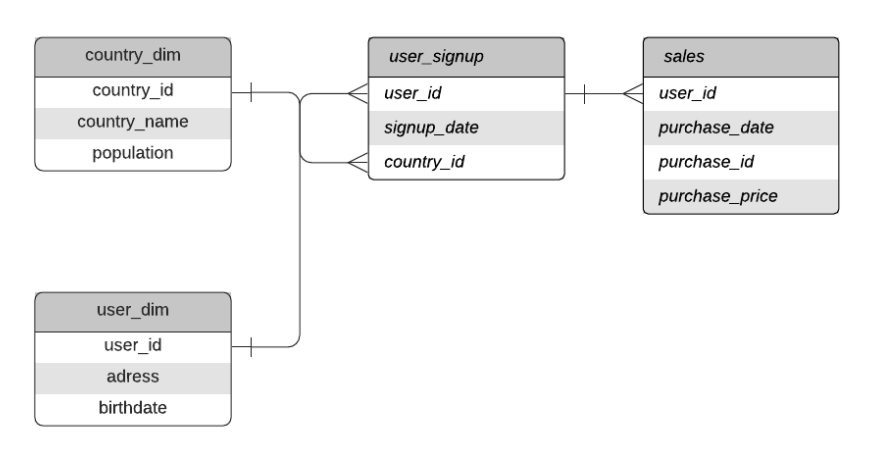Joins
Joins are a powerful part of MetricFlow and simplify the process of making all valid dimensions available for your metrics at query time, regardless of where they are defined in different semantic models. With Joins, you can also create metrics using measures from different semantic models.
Joins use entities defined in your semantic model configs as the join keys between tables. Assuming entities are defined in the semantic model, MetricFlow creates a graph using the semantic models as nodes and the join paths as edges to perform joins automatically. MetricFlow chooses the appropriate join type and avoids fan-out or chasm joins with other tables based on the entity types.
What are fan-out or chasm joins?
— Chasm joins are when two tables have a many-to-many relationship through an intermediate table, and the join results in duplicate or missing data.
Types of joins
MetricFlow automatically generates the necessary joins to the defined semantic objects, eliminating the need for you to create new semantic models or configuration files.
This document explains the different types of joins that can be used with entities and how to query them using the CLI.
MetricFlow primarily uses left joins for joins, and restricts the use of fan-out and chasm joins. Refer to the table below to identify which joins are or aren't allowed based on specific entity types to prevent the creation of risky joins.
| entity type - Table A | entity type - Table B | Join type |
|---|---|---|
| Primary | Primary | ✅ Left |
| Primary | Unique | ✅ Left |
| Primary | Foreign | ❌ Fan-out (Not allowed) |
| Unique | Primary | ✅ Left |
| Unique | Unique | ✅ Left |
| Unique | Foreign | ❌ Fan-out (Not allowed) |
| Foreign | Primary | ✅ Left |
| Foreign | Unique | ✅ Left |
| Foreign | Foreign | ❌ Fan-out (Not allowed) |
Example
The following example uses two semantic models with a common entity and shows a MetricFlow query that requires a join between the two semantic models.
Let's say you have two semantic models, transactions and user_signup as seen in the following example:
semantic_models:
- name: transactions
entities:
- name: id
type: primary
- name: user
type: foreign
expr: user_id
measures:
- name: average_purchase_price
agg: avg
expr: purchase_price
- name: user_signup
entities:
- name: user
type: primary
expr: user_id
dimensions:
- name: type
type: categorical
MetricFlow will use user_id as the join key to join two semantic models, transactions and user_signup. This enables you to query the average_purchase_price metric in transactions, sliced by the type dimension in the user_signup semantic model.
Note that the average_purchase_price measure is defined in the transactions semantic model, where user_id is a foreign entity. However, the user_signup semantic model has user_id as a primary entity.
Since this is a foreign-to-primary relationship, a left join is implemented where the transactions semantic model joins the user_signup semantic model, since the average_purchase_price measure is defined in the transactions semantic model.
When querying dimensions from different semantic models using the CLI, a double underscore (or dunder) is added to the dimension name after the joining entity. In the CLI query shown below, user_id__type is included as a dimension.
mf query --metrics average_purchase_price --dimensions metric_time,user_id__type
Multi-hop joins
MetricFlow can join three tables at most, supporting multi-hop joins with a limit of two hops.
MetricFlow allows users to join measures and dimensions across a graph of entities, which we refer to as a 'multi-hop join.' This is because users can move from one table to another like a 'hop' within a graph.
Here's an example schema for reference:

Notice how this schema can be translated into the three MetricFlow semantic models below to create the metric 'Average purchase price by country' using the purchase_price measure from the sales table and the country_name dimension from the country_dim table.
semantic_models:
- name: sales
defaults:
agg_time_dimension: first_ordered_at
entities:
- name: id
type: primary
- name: user_id
type: foreign
measures:
- name: average_purchase_price
agg: avg
expr: purchase_price
dimensions:
- name: metric_time
type: time
type_params:
- name: user_signup
entities:
- name: user_id
type: primary
- name: country_id
type: Unique
dimensions:
- name: signup_date
type: time
- name: country_dim
entities:
- name: country_id
type: primary
dimensions:
- name: country_name
type: categorical
Query multi-hop joins
To query dimensions without a multi-hop join involved, you can use the fully qualified dimension name with the syntax entity double underscore (dunder) dimension, like entity__dimension.
For dimensions retrieved by a multi-hop join, you need to additionally provide the entity path as a list, like user_id.